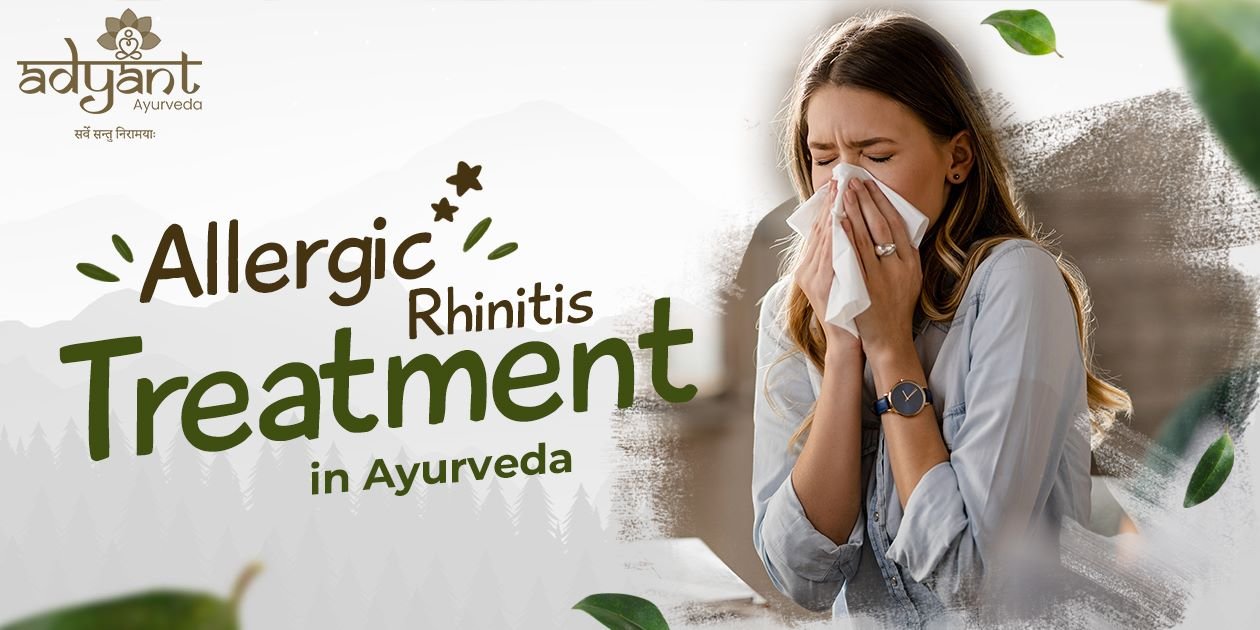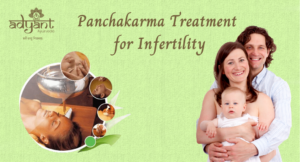Allergic Rhinitis Treatment in Ayurveda: A Holistic Approach
Introduction
Allergic rhinitis, also known as hay fever, primarily affects the upper respiratory tract, including the nostrils, nasal cavity, sinuses, throat, pharynx, and larynx. It is characterized by a runny nose, watery and red eyes, nasal congestion, sneezing, and a sore throat. This condition occurs due to an allergic reaction when an individual is exposed to allergens such as pollen, dust mites, pet dander, or mold. Unlike the common cold, allergic rhinitis is not contagious and is caused by an overactive immune response to harmless substances.
Causes and Triggers of Allergic Rhinitis
Predisposing Factors:
-
Genetic predisposition
-
Humid climate
-
Poor air quality
-
Existing respiratory conditions like asthma
-
Skin allergies such as eczema
Causative Factors:
-
Exposure to pollen, dust, or mold spores
-
Consumption of refrigerated food and drinks
-
Sudden environmental changes
-
Weak digestion leads to toxin accumulation
-
Exposure to pollutants and allergens in daily life
Symptoms of Allergic Rhinitis
-
Runny Nose: Initially watery discharge, later becoming thick and mucopurulent.
-
Headache & Sinus Pain: Due to mucus accumulation in the sinus cavities.
-
Watery Eyes: Histamine response causes swollen, itchy, red, and watery eyes.
-
Nasal Blockage: This leads to difficulty in breathing and a reduced sense of smell.
-
Cough & Sore Throat: Swelling and irritation of the airways trigger coughing.
-
Fever & Malaise: When exposed to allergens, mild fever and general discomfort may develop.
-
Change in Voice & Brain Fog: Due to inflammation of the larynx and nasal congestion.
Ayurvedic Perspective on Allergic Rhinitis (Pratishyaya)
In Ayurveda, allergic rhinitis is referred to as Pratishyaya, a condition resulting from the vitiation of Vata, Kapha, and Pitta doshas. The accumulation of toxins (Ama) due to improper digestion weakens immunity, making the body susceptible to allergic reactions.
Ayurvedic Symptoms of Pratishyaya:
-
Shirogurutva: Heaviness in the head
-
Kshavathu: Continuous sneezing
-
Aruchi: Loss of appetite
-
Mukha Shushkata: Dryness in the mouth
-
Jwara: Mild fever
-
Netra Srava: Watering of the eyes
-
Shiroshoola: Headache
Ayurvedic Treatment Approach for Allergic Rhinitis
The management focuses on detoxification, immune modulation, and symptom relief. Treatment varies based on whether the condition is in the Acute Stage (Nava Pratishyaya) or Chronic Stage (Pakwa Pratishyaya).
1. Nava Pratishyaya (Early-stage Treatment)
-
Langhana (Fasting): Light food such as Ganji, Kichadi, and Pongal for 3-5 days.
-
Swedana (Sweating Therapy): Keeping the body warm, steam inhalation, and covering ears with cotton.
-
Deepana & Pachana Herbs: Cumin, pepper, asafoetida, ajwain, garlic, ginger, and cinnamon to enhance digestion.
-
Warm Water Therapy: Drinking and bathing with warm water.
-
Home Remedies: Milk with fresh ginger juice, dry ginger with jaggery.
2. Pakwa Pratishyaya (Chronic-stage Treatment)
-
Ghritha Pana (Medicated Ghee Consumption): Strengthens immunity.
-
Environmental Care: Avoiding dust, pollution, and pollen exposure.
-
Steam Inhalation: With herbal ingredients to clear mucus blockages.
Panchakarma for Allergic Rhinitis
1. Nasya (Nasal Therapy)
Administering medicated oils (Anu Taila, Shadbindu Taila) in the nostrils to remove accumulated Kapha and clear nasal congestion.
-
Avapeedana Nasya: Used in the acute stage to reduce inflammation and promote mucus discharge.
-
Navana Nasya: Medicated ghee or oils infused with herbs like black pepper, long pepper, and rock salt.
2. Dhoomapana (Herbal Smoke Therapy)
Medicated smoke inhalation using herbs like Devadaru (Himalayan Cedar), Apamarga, Cassia Fistula, and Black Pepper to clear nasal blockages.
3. Vamana (Emesis Therapy)
Controlled vomiting to expel excessive Kapha and toxins, useful in chronic allergic rhinitis cases.
4. Virechana (Purgation Therapy)
Pitta-pacifying purgation detoxifies the digestive system and improves metabolism.
5. Basti (Medicated Enema Therapy)
Asthapana Basti is beneficial in Vata-related allergic rhinitis, helping expel toxins and restore balance.
Ayurvedic Herbal Remedies for Allergic Rhinitis
-
Haridra (Turmeric): Anti-inflammatory and antimicrobial properties.
-
Tulasi (Holy Basil): Antiallergic, immune-boosting, and respiratory tonic.
-
Ashwagandha: Strengthens the immune system and reduces stress-related flare-ups.
-
Ardraka (Ginger): Natural antihistamine, that reduces allergy-related inflammation.
-
Chyawanprash: An immunity-boosting Ayurvedic formulation rich in Vitamin C.
Diet and Lifestyle Recommendations for Allergic Rhinitis
-
Warm, easily digestible food – Soups, herbal teas, and light meals.
-
Avoid dairy, cold, and processed foods – These aggravate Kapha.
-
Practice Pranayama (Breathing Exercises): Anulom Vilom, Kapalbhati to improve respiratory function.
-
Manage Stress: Meditation and yoga help in overall wellness.
-
Proper Sleep: Restoring natural immunity and healing the body.
Conclusion
Allergic rhinitis is a manageable condition when treated with Ayurveda’s holistic approach. Identifying the dosha imbalance, detoxifying the body, and incorporating lifestyle modifications help in long-term relief. Adyant Ayurveda specializes in Ayurvedic treatments for allergic rhinitis, providing personalized care through expert consultation and natural remedies.
For professional Ayurvedic guidance, consult the best Ayurvedic doctors at Adyant Ayurveda Treatment Centre, Bangalore, and embrace a natural solution for allergic rhinitis.
FAQs on Ayurvedic Treatment for Allergic Rhinitis
1. What is Ayurvedic treatment for allergic rhinitis?
Ayurveda treats allergic rhinitis holistically by balancing doshas, detoxifying the body, and improving immunity through herbal medicines, dietary modifications, and Panchakarma therapies.
2. Which Ayurvedic herbs are effective for allergic rhinitis?
Some of the most effective herbs include Turmeric (Haridra), Tulsi (Holy Basil), Ashwagandha, Ginger (Ardraka), and Chyawanprash, which help reduce inflammation and strengthen the immune system.
3. What is Nasya therapy, and how does it help?
Nasya therapy involves administering medicated oils through the nostrils to clear nasal congestion, reduce Kapha accumulation, and improve breathing. It is highly recommended for allergic rhinitis.
4. Can Panchakarma therapy help with allergic rhinitis?
Yes, Panchakarma treatments like Vamana (emesis), Virechana (purgation), Nasya (nasal therapy), and Basti (medicated enema) help detoxify the body, improve digestion, and strengthen immunity, reducing allergic symptoms.
5. What dietary changes are recommended for allergic rhinitis in Ayurveda?
Ayurveda suggests consuming warm, light, and easily digestible foods while avoiding cold, heavy, and dairy products that increase Kapha. Herbal teas, soups, and anti-inflammatory spices like ginger and turmeric are beneficial.
6. How does stress affect allergic rhinitis, and what can be done?
Stress weakens immunity and can trigger allergic reactions. Ayurveda recommends stress management through yoga, meditation, and breathing exercises like Anulom Vilom and Kapalbhati.
7. Can Ayurvedic treatment completely cure allergic rhinitis?
While Ayurveda provides long-term relief and a significant reduction in symptoms, managing allergic rhinitis requires lifestyle modifications, regular detoxification, and immunity-boosting therapies.
8. When should I consult an Ayurvedic doctor for allergic rhinitis?
It is best to consult an Ayurvedic doctor if symptoms persist despite home remedies or if you experience recurrent allergic rhinitis. A personalized treatment plan ensures better results.






